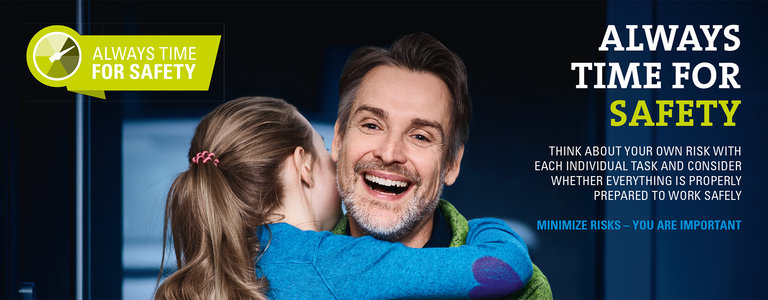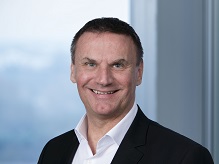
Occupational safety campaigns: The nuts and bolts: Permanent awareness
Even the best tools and methods for occupational safety are of no use if employees do not use them. That’s why a vibrant safety culture is the best guarantee for the highest level of occupational safety. Oskar Hack, Corporate HSEQ Director at Bilfinger, describes how such a safety culture is created in companies.
Why is it so important to raise employees’ awareness of occupational safety on a permanent basis?
Only through permanent repetition is it possible to positively influence actions and thus actually make work processes safer. Scientific studies have shown this time and again. The relevant messages must therefore be conveyed on a regular basis. Permanently raising awareness also shows that the company takes the issue of occupational safety very seriously and wants to create a culture in which employees work safely on their own initiative and that they want to comply with the strictest occupational safety standards.
What measures can best be used to address employees on occupational safety issues? What has been your experience at Bilfinger?
My experience has shown that the more intensively employees are involved, the more successful the measures are. Active on-site training, for example, can achieve considerably more than traditional training courses, which are mostly taught in a lecture-style format. It is important to incorporate existing knowledge and to discuss it as specifically as possible in the workplace and to practice the right steps. This is because when it comes to these procedures, the rules and standards that need to be adhered to can be better explained and – even more importantly – the reasons for these rules and standards are also made much clearer. If employees understand the reasons, they are much more likely to view occupational safety not as a chore, but as a way to protect their own health and their lives.
In your experience, what tone should these measures have in order to ensure that they are as effective as possible?
First of all, of course, it is important that there is constructive communication at all times, based on understanding and respect. For campaigns that often involve a mix of measures, it is important that they are attention-grabbing. Otherwise, there is a great risk that they will not penetrate. It is helpful to address emotions. Funny or humorous content as well as unusual designs are also good ways of ensuring that campaigns are noticed and, ideally, talked about. It is not really such a bad thing at all if the design of the campaign is also criticized. Having a robust discussion about a campaign is better than having it completely overlooked.
What role do the managers play? What are their responsibilities and how are they made aware of these responsibilities?
Managers have an extremely important role to play in all matters relating to occupational safety. Not only do they always have to serve as role models when it comes to occupational safety, they also have to be visible to everyone. That means that they have to formulate a straightforward set of expectations, actively address grievances and stand up for strict occupational safety standards at all times. They have to consistently insist that employees behave correctly, address misconduct and impose sanctions where they are necessary. At Bilfinger, one thing we cannot afford to tolerate is when managers “look the other way”. No matter how urgently an order has to be carried out: There always has to be enough time to ensure one hundred percent occupational safety.
How do you identify the issues that are addressed in your safety campaigns?
The most important sources are our HSEQ management software “ACTIVE” as well as discussions with our regional HSEQ managers and the managing directors of our subsidiaries. Many potential hazards and developments can be derived from our very powerful software, and from the discussions we learn about the greatest risks or major accident areas, as well as about the specific requirements of customers. Our current campaigns also highlight areas where we can make further improvements. One example of this is our current “Line of Fire - Keep Clear” campaign, which focuses on key aspects of the Life Saving Rules and supplements them.
Are there ways of evaluating the response to the campaigns? If so, how do you go about it?
We do not conduct a comprehensive evaluation. Once a campaign has been introduced, however, we receive feedback quite quickly on how it is being received by the operating units. This is primarily attributable to the fact that nine to twelve months usually pass between the development and launch of a campaign and a number of decision-makers are involved in the process. These include managers from the operating units, who naturally monitor the reactions to the campaigns very closely. And by communicating regularly with the operating units, as well as conducting qualification and audit visits, we learn a great deal about the opinions and attitudes of employees on site.
How do you prevent employees from becoming disengaged from the topic of occupational safety?
In my opinion, variety is the key success factor: If you keep choosing new channels and measures, have fun developing campaigns, and are passionate about the topic, occupational safety is not going to “annoy” you. Instead, it will become a popular and much-discussed topic among the workforce. This is demonstrated, for example, by the high level of participation in our Bilfinger Safety Award. Of course, there are always critics and it will never be possible to please everyone. But there is no excuse for letting up your guard, and it is certainly not easy to find the right balance in everyday working life.

Your contact for questions:
Oskar Hack
Corporate HSEQ Director Bilfinger SE
Phone +49 152 22769176
oskar.hack@bilfinger.com
